Cites are relatively new landscapes for breeding Cooper's Hawks (Accipiter cooperii) that nest commonly in urban and rural habitats throughout North America. There is a call for data that may indicate if cities are low quality, sink habitats, as for some other raptors, or if cities function as high-quality, source habitats. Source habitats should exhibit high nesting densities, high reproductive output, and they should produce net emigration to sites that offer the potential for greater fitness. There are no reports of connectivity via dispersed individuals and their reproductive success (i.e., gene flow) between rural and urban subpopulations for Cooper's Hawks in North America. We report one of the highest nesting densities in North America, one nest/238 ha in the city of Oshkosh, Wisconsin in 2015, with regular spacing of nests suggestive of the saturated, stable population which occurs elsewhere throughout the state. Averages of 4.7 eggs and 4.1 nestlings per nest in Oshkosh, respectively, rank among the highest metrics for the species, and are similar to the stable and high reproductive indices found elsewhere throughout rural and other urban Wisconsin habitats across 34 y (1980–2015). An apparent low index of hatchling mortality rate (10%), or the loss of offspring from clutch to brood counts, was also found in Oshkosh. We detected both breeding and natal dispersal, with relatively high clutch and nestling counts, among eight individual Cooper's Hawks of both sexes moving into and emigrating from Stevens Point, Wisconsin with surrounding rural habitats. Most dispersal movements were less than 10 km. A relative similarity in maximum dispersal distances across 38 y (1980–2017) for rural-to-rural movements in males (35 km) and females (79 km), with those distances in males (27 km) and females (48 km) that moved between Stevens Point and its rural surroundings, suggest the maximum extent of natal dispersal movements is not habitat-specific in Wisconsin Cooper's Hawks. Discussion of various demographic contexts, including potentially confounding ecological variables, revealed limitations to previous reports and interpretations of reproductive output and nesting densities for the species, including assessments of habitat quality. We suggest high-quality rural and urban nesting habitats in Wisconsin are not source habitats for Cooper's Hawks within the state given none comparatively appears to offer the potential for greater fitness. Therefore, there should be no net dispersal among habitat types.
How to translate text using browser tools
10 July 2019
Nesting Density and Dispersal Movements between Urban and Rural Habitats of Cooper's Hawks (Accipiter cooperii) in Wisconsin: Are These Source or Sink Habitats?
Robert N. Rosenfield,
Madeline G. Hardin,
Janelle Taylor,
Larry E. Sobolik,
Paul N. Frater
ACCESS THE FULL ARTICLE
It is not available for individual sale.
This article is only available to subscribers.
It is not available for individual sale.
It is not available for individual sale.

The American Midland Naturalist
Vol. 182 • No. 1
July 2019
Vol. 182 • No. 1
July 2019




